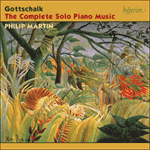
Welcome to Hyperion Records, an independent British classical label devoted to presenting high-quality recordings of music of all styles and from all periods from the twelfth century to the twenty-first.
Hyperion offers both CDs, and downloads in a number of formats. The site is also available in several languages.
Please use the dropdown buttons to set your preferred options, or use the checkbox to accept the defaults.

Originally written for two pianos, the solo version that Philip Martin plays here is by Gottschalk’s friend, the Brazilian pianist and publisher Arthur Napoleão. On four occasions, in order to accommodate the figurations in the second piano part, Napoleão introduces a third hand at the top of the keyboard with the instruction: ‘to play it like the arranger, double the number of notes, playing four [demisemiquavers] instead of two [semiquavers], and change alternate hands every four notes’. Rather than this circus act, Philip Martin has remained with the published score, overdubbing the additional line himself.
from notes by Jeremy Nicholas © 2005
Philip Martin nous propose ici une version solo (l’œuvre originale était pour deux pianos) due à l’ami de Gottschalk, le pianiste et éditeur brésilien Arthur Napoleão. À quatre reprises, ce dernier s’adapta aux figurations de la seconde partie de piano en introduisant une troisième main en haut du clavier, avec cette instruction: «à jouer comme l’arrangeur, doubler le nombre de notes, en exécutant quatre [triples croches] au leiu de deux [doubles croches], et alterner les mains toutes les quatre notes». Plutôt que de se livrer à ce numéro de cirque, Philip Martin s’en est tenu à la version publiée et a lui-même doublé la ligne supplémentaire.
extrait des notes rédigées par Jeremy Nicholas © 2005
Français: Hypérion
Ursprünglich war das Stück für zwei Klaviere gedacht. Die Fassung für einen Pianisten, die Philip Martin hier auf dieser CD spielt, stammt von Gottschalks Freund, dem brasilianischen Pianisten und Verleger Arthur Napoleão. Um den Verzierungen in der zweiten Klavierstimme gerecht zu werden, führt Napoleão an vier Stellen eine dritte Hand im oberen Teil der Tastatur ein mit dem Hinweis: „um das wie der Bearbeiter zu spielen, verdopple die Anzahl der Noten, spiele vier [Sechsunddreißigstelnoten] anstatt zwei [Sechszehntelnoten], und wechsle die Hand nach jeder vierten Note“. Statt dieses Zirkusakts hielt sich Philip Martin an die veröffentlichte Partitur und nahm die zusätzliche Stimme getrennt auf.
aus dem Begleittext von Jeremy Nicholas © 2005
Deutsch: Elke Hockings
 Gottschalk: The Complete Solo Piano Music Gottschalk: The Complete Solo Piano MusicWith his idiomatic and graceful style, pianist Philip Martin has established himself as the foremost exponent of Gottschalk. The composer had a unique spontaneity and individuality which Martin’s performances bring vividly to the fore. The complet ...» More |

